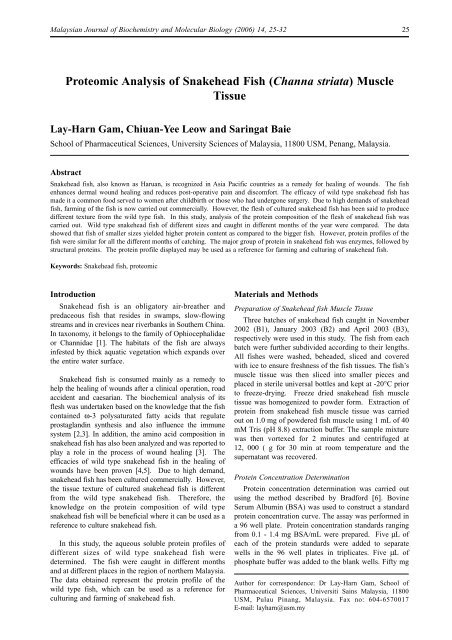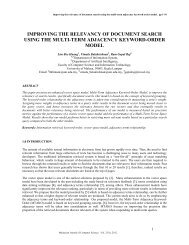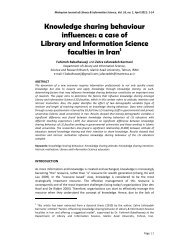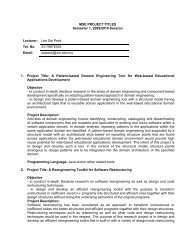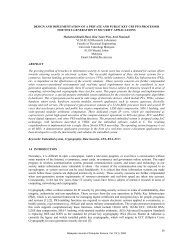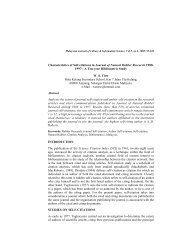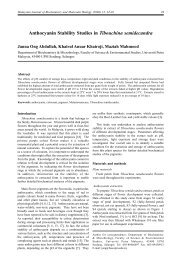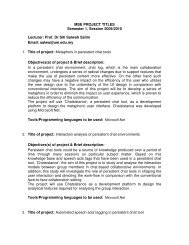Proteomic Analysis of Snakehead Fish (Channa striata ... - EJUM
Proteomic Analysis of Snakehead Fish (Channa striata ... - EJUM
Proteomic Analysis of Snakehead Fish (Channa striata ... - EJUM
You also want an ePaper? Increase the reach of your titles
YUMPU automatically turns print PDFs into web optimized ePapers that Google loves.
<strong>Proteomic</strong> analysis <strong>of</strong> snakehead fish muscle tissue27(1100 Series, Agilent, Germany). Proteins’ functions andcharacteristic information were obtained from both thePubMed (www.ncbi.nlm.nih.gov/entrez) and Swiss Prot(www.expasy.ch/sprot/sprot-top.html).Results and Discussion<strong>Snakehead</strong> fish has long been consumed as a source<strong>of</strong> dietary protein. It is also well known traditionally forits medicinal property for healing <strong>of</strong> wounds. In thisstudy, the proteins extracted from the fish’s muscle tissuewere analyzed. Different sizes <strong>of</strong> wild type snakeheadfish caught at different seasons were used in the study.The data obtained provide useful information on thenutritional and medicinal properties <strong>of</strong> snakehead fish.Culturing <strong>of</strong> snakehead fish has been carried out inMalaysia due to the high demand <strong>of</strong> the fish. As a largeproportion <strong>of</strong> fish muscle tissue is made up <strong>of</strong> proteins,cultured fish muscle tissue texture can be monitored bycomparing their protein pr<strong>of</strong>ile with those <strong>of</strong> the wildtype fish.In order to study the protein pr<strong>of</strong>ile <strong>of</strong> snakehead fish,fishes <strong>of</strong> different sizes that were caught at differentseasons were analyzed. Three batches <strong>of</strong> snakehead fishcaught in November (B1), January (B2) and March (B3),respectively were used in this study. From each batch,eight different lengths <strong>of</strong> snakehead fish were used, whichwere at 16 cm, 23 cm, 24 cm, 25 cm, 28 cm, 29 cm, 30cm and 38 cm lengths.In B1, it was found that smaller fish (16 cm and 23cm) contained significantly higher protein content(P
<strong>Proteomic</strong> analysis <strong>of</strong> snakehead fish muscle tissue28Table 1:List <strong>of</strong> water soluble proteins detected in Haruan’s muscle tissue. Band number are refer to indication mentionedin Figure 3.SWISS-PROTAccession numberProtein Name Mw pI Function Band numberKIBOA/ P00570 Adenylate kinase (EC 2.7.4.3) 21761 8.94 Enzyme 14Q804Y1 Aldolase (Fragment) 17427 8.73 Enzyme 10Q8JH72 Aldolase A. 40223 8.27 Enzyme 2,8,9,10Q7ZW73 Aldolase b, fructose-bisphosphate 39700 8.75 Enzyme 10Q6PUS4 Brain glycogen phosphorylase Pygb 97916 6.11 Enzyme 2,7Q9YGE7 Complement factor Bf-1 85034 5.90 Enzyme 1,6Q7ZU04 Creatine kinase, brain 43178 5.49 Enzyme 7,9Q804Z1 Creatine kinase 43231 6.29 Enzyme 9Q804Z2 Creatine kinase 43032 6.32 Enzyme 9Q9I8I6 Creatine kinase (EC 2.7.3.2) 46859 8.73 Enzyme 9S13164 Creatine kinase (EC 2.7.3.2) 43267 6.20 Enzyme 7,9,10Q98SS7 Creatine kinase (Fragment) 29125 8.89 Enzyme 7,9Q9DFM2 Creatine kinase (Fragment) 21139 5.79 Enzyme 9Q7T1J1 Creatine kinase brain is<strong>of</strong>orm (Fragment) 42608 5.89 Enzyme 9Q7T306 Creatine kinase CKM3 43115 6.29 Enzyme 9Q9YI16 Creatine kinase M1-CK 42983 6.21 Enzyme 2,9Q9YI15 Creatine kinase M2-CK 43133 6.22 Enzyme 9Q9YI14 Creatine kinase M3-CK 43185 6.25 Enzyme 9Q7T1J0 Creatine kinase mitochondrial is<strong>of</strong>orm precursor 47108 8.50 Enzyme 9Q7T1J3 Creatine kinase muscle is<strong>of</strong>orm 1 42713 6.32 Enzyme 9,10Q7T1J2 Creatine kinase muscle is<strong>of</strong>orm 2 42888 6.44 Enzyme 9Q7ZZM5 Enolase (Fragment) 28757 8.15 Enzyme 6Q6TH14 (AAQ97775) Enolase 1 (AY398342 NID) 47848 - Enzyme 6Q6GQM9 Enolase 2 47160 4.77 Enzyme 6O57518 Fructose-1, 6-bisphosphate aldolase 39957 6.21 Enzyme 10Q76BF6 Phosphoglycerate kinase (Fragment) 41657 6.04 Enzyme 9Q8AY84 Phosphoglycerate kinase (Fragment) 11317 4.67 Enzyme 9Q6NXD1 PKM 2 protein 58598 6.36 Enzyme 5Q803D2 Platelet-activating factor acetylhydrolase, is<strong>of</strong>orm 47080 6.97 Enzyme 7Ib, alpha subunit b.Q76IM5 Pol-like protein 149432 9.28 Enzyme 11,12Q7SXV3 Pygb protein (Fragment) 60118 7.30 Enzyme 7Q8JJC2 Pyruvate kinase 58767 6.35 Enzyme 5Q8QGU8 Pyruvate kinase 58582 7.96 Enzyme 5Q7M558 Replicase/ helicase/ endonuclease 350347 8.68 Enzyme 9BAD04856 (Q76B34) Reverse transcriptase 132804 - Enzyme 14Q7T040 Solble guanylyl cylase alpha2 subunit 90214 7.54 Enzyme 10Q8UW40 ST7 protein 58059 7.03 Enzyme 14Q6DR47 Topoisomerase 2 (Top 2A protein) 178147 8.93 Enzyme 2,5,8,10,11,12, 13, 14, 15Q76BE1 Triose phosphate isomerase (Fragment) 25178 6.00 Enzyme 11Q7T315 Triosephospahte isomerase 1b 27100 6.90 Enzyme 11,12Q90XF8 Triosephosphate isomerase B 26476 7.60 Enzyme 12Q9PWD1 TYK2 tyrosine kinase 129986 8.38 Enzyme 7,9Q7ZU23 Actin, alpha 1, skeletal muscle 42304 5.23 Structural 2Q6TNW2 Actinin, alpha 2. 104086 5.23 Structural 7Q6DHS1 Actin, alpha 2, smooth muscle, aorta 42374 5.23 Structural 2
<strong>Proteomic</strong> analysis <strong>of</strong> snakehead fish muscle tissue29SWISS-PROTAccession numberProtein Name Mw pI Function Band numberQ90333 Fast skeletal myosin light chain 3 16794 4.40 Structural 10Q6QUR3 Myosin heavy chain (Fragment) 23564 8.39 Structural 9Q7T2J3 Skeletal muscle actin (Fragment) 43041 6.44 Structural 2Q76BG1 Fructose-bisphosphate aldolase A 36509 8.09 Enzyme 9(Fragment)ALFB_SPAAU Fructose-bisphosphate aldolase B 40069 8.42 Enzyme 8,9,10(EC 4.1.2.13)Q90Z48 Glyceraldehyde phosphate dehydrogenase 36425 7.23 Enzyme 10(EC 1.2.1.12)Q8AWX8 Glyceraldehyde-3-phosphate dehydrogenase 36244 7.74 Enzyme 10Q8JIQ0 Glyceraldehyde-3-phosphate dehydrogenase 36069 8.63 Enzyme 10(EC 1.2.1.12)Q9PTW5 Glyceraldehyde-3-phosphate dehydrogenase 36192 8.54 Enzyme 10(EC 1.2.1.12)LDHA_ SPHAG L-lactate dehydrogenase A chain 36650 8.09 Enzyme 10(EC 1.1.1.27)LDHA_CHAAC L-lactate dehydrogenase A chain 36261 6.67 Enzyme 8(EC 1.1.1.27)LDHA_CYPCA L-lactate dehydrogenase A chain 36413 7.31 Enzyme 10(EC 1.1.1.27)LDHA_ELEMC L-lactate dehydrogenase A chain 36387 6.49 Enzyme 10(EC 1.1.1.27)LDHA_HARAN L-lactate dehydrogenase A chain 36200 6.67 Enzyme 10(EC 1.1.1.27)LDHA_BRARE L-lactate dehydrogenase A chain 36382 6.91 Enzyme 10(EC 1.1.1.27)Q9PV91 Muscle creatine kinase 43041 6.44 Enzyme 2Q90X19 Muscle-specific creatine kinase 43030 6.32 Enzyme 9Q8JH39 Muscle-type creatine kinase CKM1 43351 6.98 Enzyme 9Q8JH38 Muscle-type creatine kinase CKM2 42985 6.44 Enzyme 1,7,9Q9DFL9 Nuclease diphosphate kinase B 17218 6.82 Enzyme 15Q9PTF3 Nucleoside diphosphate kinase- Z3 19562 7.68 EnzEnzymeyme 15Q8QFU1 Phosphoglucose isomerase -2 62173 6.82 Enzyme 5Q8QFT1 Phosphoglucose isomerase-2 (EC 5.3.1.9) 62166 7.85 Enzyme 5Q90YR3 40S ribosomal protein S11 18610 10.47 Ribosomal 10Q7ZV05 Similar to 40S ribosomal protein S11 18568 10.47 Ribosomal 10Q8QGQ9 Teashirt-like zinc finger protein (Fragment) 95735 8.03 Transcription factor 9Q9I8L6 T-box transcription factor 49606 7.78 Transcription factor 13Q8UWF2 Glutamate receptor subunit 1B (Fragment) 62737 8.10 Transport 5JC4956/ Q90W12 Vitellogenin precursor 184710 9.07 Calcium ion binding 5Q9PVM6 Elongation factor 1 alpha 50743 9.16 Translation Factor 7Q7T1U2 Tmc2-related protein 2 (Fragment) 75970 5.99 Translation Factor 7Q90XI6 RAG2 (Fragment) 17314 9.01 DNA-RNA -binding 7Q98TT9 GDNF family receptor alpha-1a 54506 8.45 Signal transduction 10Q7SYD3 zgc: 67559 protein (Hypothetical protein) 104082 5.09 Hypothetical protein 7Q6DG54 Zgc:92037 58897 6.88 Hypothetical protein 5AAH59437 zgc: 73059 (BC059437 NID) 46671 - Hypothetical protein 9AAH59571 (Q6PBV4) zgc: 73229 protein (BC059571 NID) 29926 5.61 Hypothetical protein 7Q6NXB1 Hypothetical protein zgc:77002 34254 5.44 Hypothetical protein 12Q7ZZ46 SI:dZ249N21.1.3 (Novel protein similar 455282 5.32 Hypothetical protein 9to human titin (TTN) (Fragment)Q7ZV29 zgc: 56252 (Similar to phosphoglycerate 45126 6.47 Hypothetical protein 9kinase 1)
<strong>Proteomic</strong> analysis <strong>of</strong> snakehead fish muscle tissue30The protein pr<strong>of</strong>ile <strong>of</strong> the aqueous soluble proteinextracted from various sizes snakehead fish muscle tissuesfrom B2 and B3 is shown in figure 3 (protein pr<strong>of</strong>ile <strong>of</strong>B1 is not shown; there was no variation between thethree batches). Each <strong>of</strong> the lanes was loaded with similaramounts (50 µg) <strong>of</strong> protein extracts from fish <strong>of</strong> differentlengths. Lanes 1 to 6 represent the protein pr<strong>of</strong>iles fromB2 snakehead fish at 23, 24, 25, 28, 29 and 30 cm fish’slength, respectively. Lanes 7 to 14 represent the proteinpr<strong>of</strong>iles <strong>of</strong> B3 snakehead fish at 16, 23, 24, 25, 28, 29, 30and 38 cm fish’s length, respectively. The protein pr<strong>of</strong>iles<strong>of</strong> fish with different lengths and month <strong>of</strong> catches didnot differ significantly. Upon Coomassie Blue staining,protein bands, which were evenly distributed in the range<strong>of</strong> molecular masses from 10 kDa to 205 kDa weredetected. The relative intensity <strong>of</strong> the protein band ineach lane was evaluated using densitometry analysis(Figure 4). In addition to the similar protein pr<strong>of</strong>iledisplayed by all the fish, the relative intensity <strong>of</strong> theproteins is also similar. Thus, the non-variable features(protein pr<strong>of</strong>iles and bands intensity) shown by wild typesnakehead fish is beneficial for monitoring <strong>of</strong> the proteincomposition <strong>of</strong> cultured snakehead fish.The list <strong>of</strong> proteins that were identified in this study isshown in table 1. Approximately 43.5 % <strong>of</strong> the totalproteins identified in snakehead fish muscle tissue werebasic proteins. These basic proteins have theoretical pIvalues <strong>of</strong> between 7.03 and 10.47. Forty-five proteins or52.9 % <strong>of</strong> the total proteins were identified as acidicproteins. Their pI values were ranged from 4.40 to 6.98.pI <strong>of</strong> three <strong>of</strong> the identified proteins were not shown inthe database.Figure 3: SDS-PAGE aqueous soluble protein pr<strong>of</strong>ile <strong>of</strong>snakehead fish muscle tissue proteins from batch2 (B2) and batch 3 (B3). Protein bands werestained with Coomassie Blue. Lanes 1-6 representprotein pr<strong>of</strong>iles from B2 fish with 23, 24, 25, 28,29 and 30 (cm) fish length, respectively. Lanes 7-14 represent protein pr<strong>of</strong>iles from fish <strong>of</strong> B3 with16, 23, 24, 25, 28, 29, 30 and 38 cm fish length,respectively. Lane M represents the proteinmarkers with molecular weights shown on theleft. The last lane on the right shows the labeled<strong>of</strong> protein bands which correspond to the proteinband number in Table 1.Figure 4: Three dimensional densitometric analysis <strong>of</strong> SDS-PAGE from Figure 3. Traces from 1 - 14 representthe different protein lanes in SDS-PAGE. Peakscorrespond to bands <strong>of</strong> SDS-PAGE. Trace Mrepresents protein markers.In general, there was a good correlation between theobserved and theoretical molecular weight (M r ) values <strong>of</strong>the identified proteins. However, thirteen proteins showedheterogeneity and were represented by more than oneband. These proteins include Aldolase A. (SWISS-PROTaccession number: Q8JH72), Brain glycogenphosphorylase Pygb (SWISS-PROT accession number:Q6PUS4), Complement factor Bf-1 (SWISS-PROTaccession number: Q9YGE7), Creatine kinase (EC 2.7.3.2)(SWISS-PROT accession number: S13164), Creatinekinase, brain (SWISS-PROT accession number: Q7ZU04),Creatine kinase M1-CK (SWISS-PROT accession number:Q9YI16), Creatine kinase muscle is<strong>of</strong>orm 1 (SWISS-PROT accession number: Q7T1J3), Creatine kinase(Fragment) (SWISS-PROT accession number: Q98SS7),Fructose-bisphosphate aldolase B (EC 4.1.2.13) (SWISS-PROT accession number: ALFB_SPAAU), Muscle-typecreatine kinase CKM2 (SWISS-PROT accession number:Q8JH38), Pol-like protein (SWISS-PROT accessionnumber: Q76IM5), TYK2 tyrosine kinase (SWISS-PROTaccession number: Q9PWD1), Topoisomerase 2(fragment) (SWISS-PROT accession number: Q6DR47)and Triosephosphate isomerase 1b (SWISS-PROTaccession number: Q7T315). In this study, all the proteins’identities were successfully assigned except for theproteins bands 4, 5 and 16, which may indicate theirnovel nature.A total <strong>of</strong> 85 proteins were identified in snakeheadfish muscle tissue. About 73 % <strong>of</strong> the total identifiedproteins were classified as enzymes or enzyme subunitswith various catalytic activities (Figure 5). Six <strong>of</strong> theproteins identified were structural proteins. Other proteinswere found to be responsible for cellular activities suchas the ribosomal protein, transcription factor, transport
<strong>Proteomic</strong> analysis <strong>of</strong> snakehead fish muscle tissue31protein, calcium ion binding protein, DNA/RNA-bindingprotein and signal transduction protein, which made up aminor constituent that consist <strong>of</strong> less than 2.4 % <strong>of</strong> thetotal protein detected. Moreover, a series <strong>of</strong> hypotheticalproteins or unknown gene products (about 8.2 % <strong>of</strong> thetotal proteins) were also identified in this study. Generally,hypothetical proteins are still considered as a group <strong>of</strong>proteins that have no indication about their existence atthe protein level. Most <strong>of</strong> them have been only describedat the nucleic acid level as well as predicted from cDNAsequences but were never been identified by proteinchemical method so far [12,13].The major group <strong>of</strong> enzymes identified belonged tosarcoplasmic proteins, which is mainly composed <strong>of</strong>enzymes associated with energy-producing metabolism[14]. The identified sarcoplasmic proteins were found toresponsible for the glycolysis activity and ATP hydrolysis.Among the enzymes, kinases are the most frequentlyidentified proteins. It was revealed that twenty-sevenproteins or 31.8 % <strong>of</strong> the total identified proteins werecategorized as kinases. The proportional <strong>of</strong> majorenzymes found in snakehead fish muscle tissue is shownin Figure 5. These enzymes include kinases, aldolase,dehydrogenase, isomerase, enolase and others. Bynumber, six proteins (7.1 %) were responsible for aldolaseactivity. Ten proteins (11.8 %) were classified asdehydrogenase and another six proteins (7.1 %) wereknown as isomerase. Three proteins (3.5 %) were derivedfrom enolase family. A series <strong>of</strong> glycolytic enzymeswere identified in this study. These proteins werePhosphoglucose isomerase-2, Aldolase (also known asFructose 1,6-biphosphate aldolase), Triosephosphateisomerase, Glyceraldehyde-3-phosphate dehydrogenase,Phosphoglycerate kinase, Enolase, Pyruvate kinase andL-lactate dehydrogenase.Number <strong>of</strong> IdentifiedProteins302520151050KinaseAldolaseDehydrogenaseIsomeraseEnzymesEnolaseOthersFigure 5: Various types <strong>of</strong> enzymes identified in <strong>Snakehead</strong>fish muscle tissue.In addition to sarcoplasmic proteins, my<strong>of</strong>ibrillarprotein or structural protein is also made up the majorgroup <strong>of</strong> protein identified in snakehead fish. There werea total <strong>of</strong> six different my<strong>of</strong>ibrillar proteins detected;they were actin (alpha 1, skeletal muscle), actinin (alpha2), actin (alpha 2, smooth muscle, aorta), fast skeletalmyosin light chain 3, myosin heavy chain (fragment) andskeletal muscle actin (fragment). Other than these majorproteins, some minor proteins such as Complement factorBf-1, Brain glycogen phosphorylase Pygb, Pol-likeprotein, Platelet-activating factor acetylhydrolase (is<strong>of</strong>ormIb, alpha subunit b), Pygb protein (Fragment), Replicase/helicase/endonuclease, Reverse transcriptase, Solbleguanylyl cylase alpha2 subunit, ST7 protein and manymore (as listed in Table 1) were also found in snakeheadfish muscle tissue. These proteins were detected as lowabundant proteins in snakehead fish muscle tissue.The list <strong>of</strong> protein identified in snakehead fish muscletissue (Table 1) shown that the glycolytic and ATPmetabolism are the main activities <strong>of</strong> the fish muscletissue. Both <strong>of</strong> these metabolic specializations areessentially required for power locomotor in fish. Thehigh abundance <strong>of</strong> these two groups <strong>of</strong> enzyme togetherwith my<strong>of</strong>ibrillar proteins suggests that snakehead fishmuscle is composed mainly <strong>of</strong> white muscle tissue.ConclusionThe protein pr<strong>of</strong>iles <strong>of</strong> snakehead fish <strong>of</strong> differentsizes that were caught in different months <strong>of</strong> the yearwere compared. The results showed that all the fisheshave similar protein pr<strong>of</strong>iles, where each protein bandconsisted <strong>of</strong> identical proteins. Furthermore, the relativeintensity <strong>of</strong> protein bands <strong>of</strong> all the fishes analyzed isalso similar. In view <strong>of</strong> high demands <strong>of</strong> snakehead fish,culturing <strong>of</strong> the fish is the only solution. The presentdata can be used as a reference for obtaining culturedsnakehead fish most similar in fish muscle proteincomposition to the wild type fish.AcknowledgementsWe would like to thank Universiti Sains Malaysianshort term grant for providing financial support to carryout this project. We also want to extend our gratitudeto National Poison Centre, USM for providinginfrastructure for analysis <strong>of</strong> proteins. Last but notleast we appreciate the PubMed, Swiss Prot and alsothe MatrixScience that supply free protein s<strong>of</strong>tware forprotein identification.
<strong>Proteomic</strong> analysis <strong>of</strong> snakehead fish muscle tissue32References1. Qasim. The growth <strong>of</strong> the freshwater murrel, Ophiocephaluspunctatus Bloch. Hydrogiologica 1966; 27: 289-316.2. Bowman WC and Rand MJ. Textbook <strong>of</strong> Pharmacology,2 nd Ed. Blackwell Sci. Pub., Oxford, London. 1980.3. Mat Jais AM, McCulloch R and Cr<strong>of</strong>t K. Fatty Acid andamino acid composition in Haruan as a Potential Role inWound Healing. Gen. Pharmac1994; 25: 947-950.4. Baie S Hj, Sheikh KA. The wound healing properties <strong>of</strong><strong>Channa</strong> striatus-cetrimide cream-tensile strengthmeasurement. J. Ethnopharm. 2000a; 71: 93-100.5. Baie S Hj, Sheikh KA. The wound healing properties <strong>of</strong><strong>Channa</strong> striatus-cetrimide cream-wound contraction andglycosaminoglycan measurement. J. Ethnopharm. 2000b;73: 15-30.6. Bradford, MM. A rapid and sensitive method for thequantification <strong>of</strong> microgram quantities <strong>of</strong> protein utilizingthe principle <strong>of</strong> protein-dye binding. Analyt. Biochem.1976; 72: 248-254.7. Laemmli UK. Cleavage <strong>of</strong> Structural Proteins during theAssembly <strong>of</strong> the Head <strong>of</strong> Bacteriophage T4. Nature. 1970;227: 680-685.8. Shevchenko A, Matthias W, Vorm O and Mann M.. Massspectrometric sequencing <strong>of</strong> protein from silver-stainedpolyacrylamide gels. Anal. Chem. 1996;68: 850-858.9. Perkin DN, Pappin DJC, Creasy DM and Cottrell JS.Probability-based protein identification by searchingsequence databases using mass spectrometry data.Electrophoresis. 1999; 20: 3551-3567.10. Ng PKL, and Lim KKP. <strong>Snakehead</strong>s (Pisces: Channidae):Natural history, biology and economic importance. InEssays in Zoology. Paper Commemorating the 40 thAnnivesary <strong>of</strong> the Department <strong>of</strong> Zoology, NationalUniversity <strong>of</strong> Singapore (ed. Chou L. M. and. Ng P. N. L),pp. 127-152. Department <strong>of</strong> Zoology, National UniversityOf Singapore, Singapore. 1990.11. Folkvord A. and Ottera H. Effects <strong>of</strong> initial size distribution,day length, and feeding frequency on growth, survival andcannibalism in juvenile Atlantic cod (Gadus morhua L.).Aquaculture. 1993; 114: 243-260.12. Fountoulakis M, Tsangaris G, Oh J, Maris A and Lubec G.Protein pr<strong>of</strong>ile <strong>of</strong> the HeLa cell line. J. Chromato. A.2004;1038: 247-265.13. Afjehi-Sadat L, Shin J, Felizardo M, Lee K, Slavc I andLubec G. Detection <strong>of</strong> hypothetical proteins in 10 individualhuman cell lines. Biochim. Biophy. Acta. 2005; 1747: 67-80.14. Nakagawa T, Watabe S and Hanshimoto K. Identification<strong>of</strong> three major components in fish sarcoplamic proteins.Nippon Suisan Gakkaishi. 1988; 54 (6): 999-1004.


